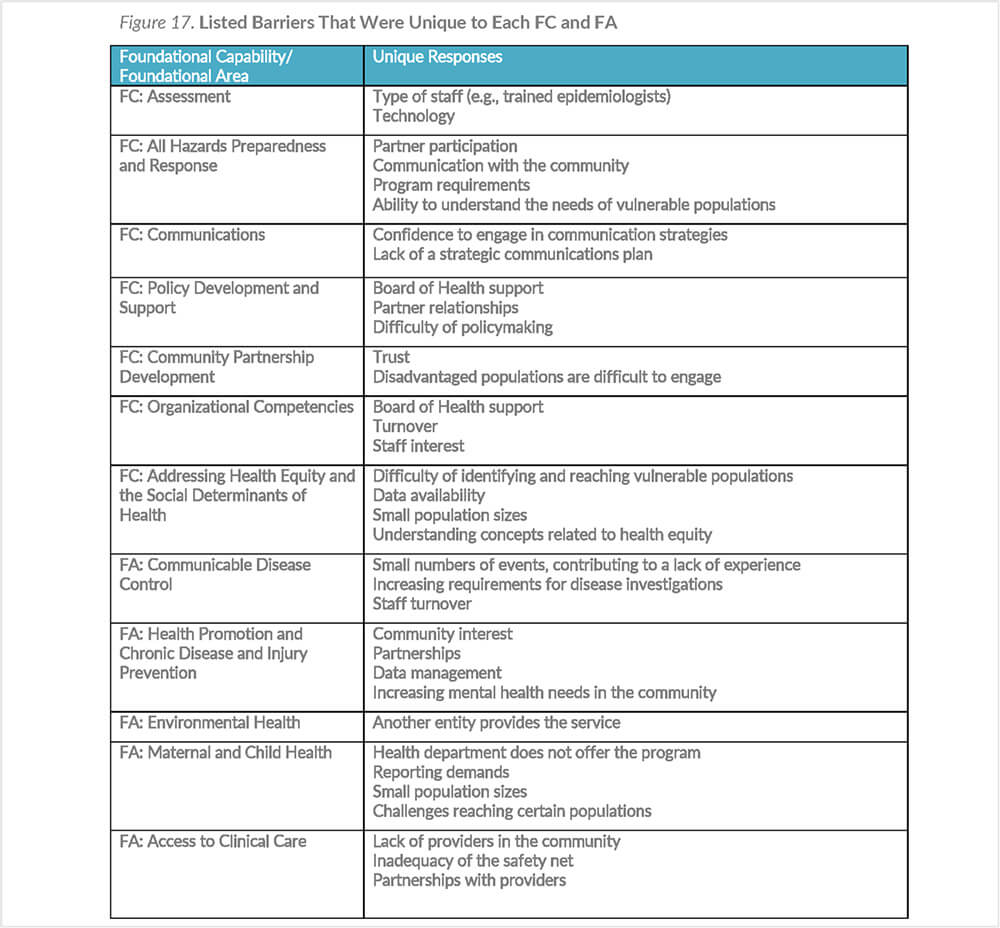Overview
Assessing the Foundational Public Health Services (FPHS) helps states understand the vital role of governmental public health in communities, identify capacity gaps, determine the cost for assuring Foundational Capabilities and Areas, justify funding requests, and achieve equitable outcomes for all. Several states that are part of the 21st Century (21C) Learning Community have undertaken assessment processes that have resulted in real impact. In August 2022, we wrote about the assessment work of Ohio, Oregon, and Washington in the Assessing the Capacity and Cost of Public Health Systems to Implement the FPHS blog, and now we are sharing examples from three more states.
Colorado
In 2019, the Colorado Association of Local Public Health Officials (CALPHO) and the Colorado Department of Public Health and Environment (CDPHE) conducted a comprehensive needs assessment to understand current statewide implementation and spending on core public health services, and to estimate the cost to fully deliver those services statewide based on current service delivery models. The assessment was completed by CDPHE and 53 local public health agencies (LPHAs), as well as close governmental partners Denver Public Health and Northwest Colorado Health. Key findings include:
- Colorado’s governmental public health system has achieved a basic level of implementation, with core public health services implemented at approximately 61% across the governmental public health system.
- The Assessment & Planning (which includes data capacities) capability and the Communicable Disease Prevention, Education & Control service are the most implemented statewide.
- The Health Equity & Social Determinants of Health capability and the Access to and Linkage with Health Care service are the least implemented statewide.
- Colorado spent about $278 million on core public health services in 2018 (mostly from federal funding sources), and the assessment estimates that the state would need to spend or allocate $188 million more to support full implementation.

Colorado Public Health System Transformation Core Public Health Services Needs Assessment Report, January 2020. www.calpho.org/uploads/6/8/7/2/68728279/final_colorado_cphs_needs_assessment_overall_report_2020_01.pdf
Kansas
In 2017, the Kansas Public Health Systems Group conducted a FPHS Capacity Assessment to examine how local health department administrators rated their department’s capacity (defined as staff, time, and funding) and capability (defined as skills, knowledge, and expertise) to deliver each of the 109 components of the Kansas FPHS model. The assessment was completed by 80% of local health departments, representing 86 of the 105 counties in Kansas. Key findings include:
- Local health department administrators rated their capacity to deliver the FPHS lower than the capability to do so. In other words, the level of staff, time, and funding is perceived as less sufficient than the skills, knowledge, and expertise to deliver these public health services.
- Health departments in Kansas already have the capability and capacity to implement some portions of the Kansas FPHS model. Foundational Capabilities (FC) and Foundational Areas (FA) of the model that were most highly rated were the All Hazards Preparedness and Response capability; Organizational Competencies capability; Communicable Disease Control area; and Access to Clinical Care area.
- The areas with the biggest opportunities for improvement were the Policy Development and Support capability; Assessment capability; and Environmental Health area.
- Some of the components that were most highly rated reflect traditional public health department roles, such as the ability to assure immunization coverage. Those that rated lowest often reflected newer ideas or concepts in public health, such as the ability to engage in Health in All Policies and participation in land use and development planning.
- Administrators of local public health agencies that serve more population-dense counties generally reported higher capacity and capability than those that serve more sparsely populated areas.
- The number of staff employed at local health departments may also impact the capacity to implement the FPHS. A higher number of full-time equivalents (FTEs) was associated with higher capacity, and more than half of the respondents had five FTEs or fewer. These small staff numbers may be insufficient to cover all the components of the FCs and FAs.

Kansas Foundational Public Health Services Capacity Assessment, August 2017. www.khi.org/wp-content/uploads/2022/05/Foundational-Public-Health-Services-Capacity-Assessment.pdf
Missouri
In 2020, #HealthierMO partnered with the Missouri Department of Health and Senior Services to conduct an infrastructure and capacity assessment survey of Missouri’s LPHAs. Nearly all (112 of 115) of the LPHAs completed the survey, self-assessing and reporting their own agency’s capacity to assure the foundational public health capabilities and areas of expertise identified in the Missouri FPHS model. Key findings include:
- FPHS capacity varies widely across LPHAs in the state. Capacity differences were not driven by urban or rural location – both the largest urban and smallest rural LPHAs are assuring capabilities and areas at rates higher than expected from others throughout the state. However, densely settled rural and semi-urban LPHAs were slightly less likely to assure either areas or capabilities but were more likely to assure the areas without assuring the capabilities.
- The level of per capita funding drives capacity. Assessment data analysis revealed per-capita funding alone (apart from any other variable) distinguished LPHAs with capacity to assure FPHS from those who lack capacity. The mean difference in per capita funding among LPHAs with capacity compared to those lacking capacity is approximately $6.50 for capabilities and $10.00 for areas.
- Administrator experience and focus on a single role influences their agency’s capacity. LPHAs are more likely to have higher capacity when their administrator has two or more years of experience in the administrator/director role and focuses solely on administrative functions, rather than filling multiple positions within the organization.
- Capacity in the FPHS capabilities is a strong predictor of capacity in the areas of expertise. LPHAs with a higher capacity to assure capabilities (like organizational administrative competencies, communication, and policy development) are 2.3 times more likely to also have higher capacity in the public health areas of expertise. Only 42.6% of LPHAs who did not assure the capabilities were able to assure the areas, compared to 98% of LPHAs who did assure the capabilities. Capacity in the seven capabilities depends on strong leadership skills and successful workforce development.
- Communicable disease control ranked as the area of expertise with the highest capacity across the state. This finding was illustrated by the dynamic public health response to COVID-19, which depended heavily on communicable disease control activities like investigations, contact tracing, non-pharmaceutical interventions such as isolation and quarantine, and vaccinations.

Local Public Health Capacity to Assure Foundational Public Health Services in Missouri, 2021. www.healthiermo.org/_files/ugd/9bd019_91e2bb4a2c3242f6a03e9cb7a65bab88.pdf
Public Health Systems Transformation
The examples provided were all completed prior to the development of the FPHS Capacity and Cost Assessment, where states performed assessments to support their public health transformation efforts, and demonstrated the value an assessment could bring to their efforts. In the examples provided, important resources like state funding, contractors, and staff time were needed to support the implementation in each state. The FPHS Capacity and Cost Assessment was developed to provide a similar assessment tool to governmental public health departments at no cost. We hope this tool will add similar value to states that use it to assess their capacity to provide the FPHS.
Now that more states are moving forward with transformation plans post-COVID-19 response and as part of CDC’s Public Health Infrastructure Grant Program efforts, we anticipate learning more about state plans to assess capacity and cost to implement the FPHS. Stay tuned to our 21C Learning Community webpage for more details.
Public Health Systems Transformation
PHAB’s Center for Innovation, in collaboration with the University of Minnesota Center for Public Health Systems, launched the FPHS Capacity and Cost Assessment to support health departments and health department systems in understanding their current spending and capacity towards the FPHS, and the needed investments to fully implement the FPHS. Completion of this assessment will require the participation of both agency finance and program staff and was developed to support public health system transformation.
To learn more about the FPHS Capacity and Cost Assessment, view the launch webinar below and visit the tool website.





